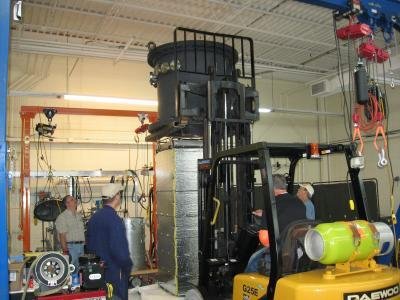Researchers and staff at UT's Magnet Development Laboratory prepare the central solenoid mockup for the vacuum pressure impregnation process. Credit: University of Tennessee, Knoxville
KNOXVILLE, Tenn., June 8 (UPI) -- U.S. researchers say they've completed an important step in developing a key technology that could lead to clean nuclear fusion power.
Researchers at the University of Tennessee, Knoxville, are part of an international effort to develop an experimental reactor that can demonstrate the feasibility of fusion energy for the power grid.
The project, known as ITER, is building a fusion reactor near Cadarache, France, that aims to produce 10 times as much energy as it uses.
The Tennessee researchers have successfully tested a technology that will insulate and provide structural integrity to the 1,000-ton central solenoid, the reactor's "backbone."
A fusion reactor uses magnetic fields to confine the plasma within it, and the central solenoid, which consists of six giant coils stacked on top of one another, plays a vital role by both igniting and steering the plasma current.
Researchers had to find the right material --a glass fiber and epoxy chemical mixture that is liquid at high temperatures and turns hard when cured -- and the right process of inserting this material into all of the necessary spaces inside the central solenoid.
The UT team has tested the technology inside its mockup of the central solenoid conductor, a university release reported Friday.
It took two years to develop the technology and more than two days to impregnate the central solenoid mockup, researchers said.
The ITER experimental reactor in France is set to begin operations in 2020.















